Jamun /Jamoon, Java Plum or (tropical) Black Plum:
Syzygium cumini / aka Eugenia cumini
aka Jamoon, jambul, jambolan, Duhat, Java plum, Portuguese plum; sometimes mistakenly called Indian blackberry,
zones 8-11 (see note below)
clarification about growing zones for Jamun:
Jamun can withstand brief periods at 30 degrees, so grown with winter protection in zones 8a-9a,
but more suitable outdoors to southern parts of zone9a-11
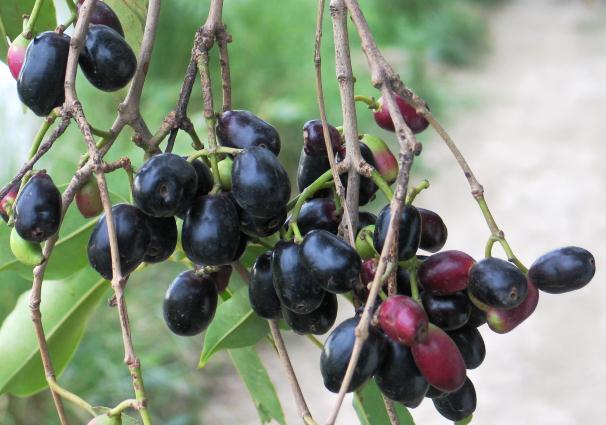
Jamun fruit: aka (tropical) Black plum
Jamun in India
Jamun or Black Plum is a hardy evergreen tropical tree in the myrtle family from India & SE Asia that produces small ovoid shaped "plums" about the size of large olives. Introduced to Florida in 1911 by the USDA, Jamun trees can be invasive in tropical areas of the western hemisphere, especially in zone 10b, and are now banned in Sanibel, FL (zone 10a).
Jamun trees easily grow 30-35'tall in their native India, and bear fruit continuously for 60-70 years. An organic farmer in Dindugal, succeeded in aggressively pruning his orchard to 18-20', while maintaining heavy yields. His 8 yr old trees produced about 85-110 lbs fruit each, while his 11 yr old trees now produce about 110-150 lbs fruit per tree.
And just for reference: he planted his trees 24' apart. Read more here.
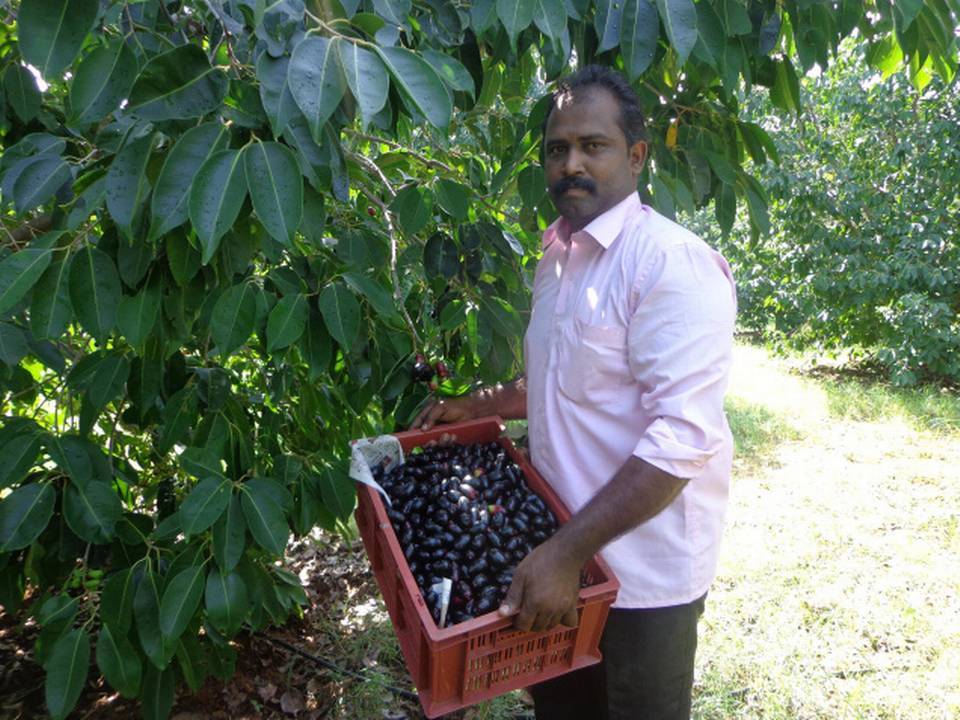
organic jamun farm in Dindugal, India

mature jamun specimen, allowed to grow tall
The tree is used to shade the coffee crop in India, and is quite wind resistant. It can also be topped out and forms a massive hedge. In parts of South Florida, it grows too well and has become a nuisance, and as such has lost favor. Agriculture advisors prefer to recommend a cousin of this tree: wax jambu (Syzygium samarangense) or rose apple, found here.
Growth
Black Plum is a dense evergreen with leathery, glossy dark green leaves that develop a yellow midrib at maturity. New emerging foliage is a pinkish color, and have an aroma of turpentine. Can be an attractive shade tree. Seems very tolerant of low wet areas as well as higher well, drained land, and can even withstand prolonged flooding. Doesn't mind high winds, but doesn't tolerate salt water. Likes full sun best.
Most sources say Jamun is a long-lived, fast growing tree, possibly as tall as 50-100' at maturity. Expect 35-40' in Florida. All parts of the tree can be used: the wood is highly water resistant, leaves are sometimes fed to livestock, and of course there's the fruit. Even the seed is used in some Ayurvedic formulas.
Jamun, sometimes known simply as "Black plum", is a native of India, Burma, and Ceylon. It has been introduced to the Philippines, Java, East Indies, Australia, parts of South America, Hawaii, and of course Florida in 1911. It loves full sun, and somewhat acidic soils: 5.6-6.0 pH.
Fruits
Black plums begin to bear fruit around 4-5 yrs of age, though some sources report 8-10 years to start bearing.
Blooming time is late February to early March in southern Florida, with fruit ripening in early to mid-summer: late May through July. Sometimes late blooms will produce fruit into October.
Trees are self pollinating, with both insect and wind pollination, resulting in about 30-40% fruit set -- pretty good numbers for fruit trees. However, cross-pollination with a second tree increases yields to about 40-50% fruit set -- not crucial for the average home orchard. So one tree will produce plenty of fruit for most individual needs.
The small, oval, olive-sized fruits are quite juicy and contain a single seed. It is said to be a good source of iron, and has been found to contain several important bioactive phytochemicals, antioxidants, flavonoids and many medicinal properties.
Fruit is green when unripe, changing to pink, then red, and finally black when fully ripe. Flavor is a combination of sweet-tart and a little astringent, and can range anywhere from acidic to fairly sweet. Feed your tree with organic amendments and trace minerals to enhance depth of flavor and sweetness.
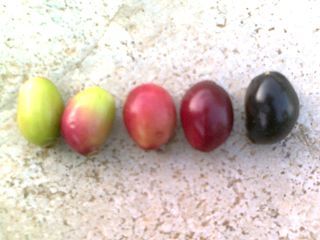
various shades of ripening fruit / photo credits
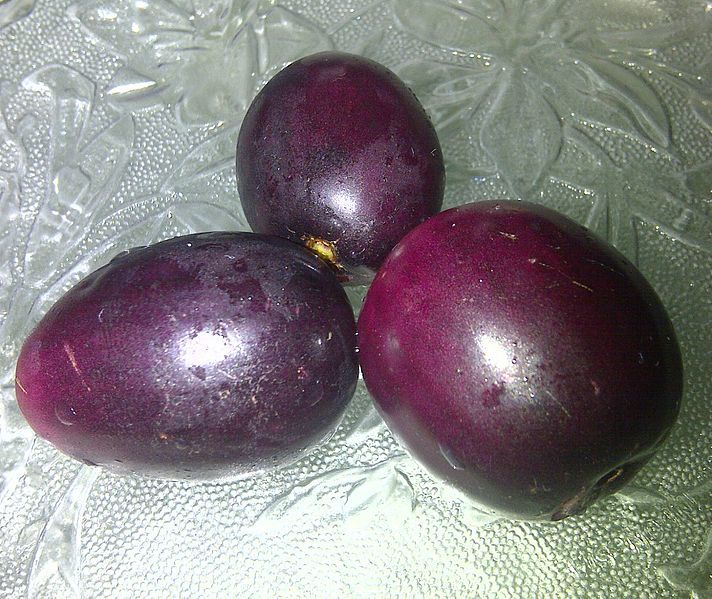
fully ripe jamun / photo credit
Fruits will turn the tonque purple -- and stain clothes, etc, just like mulberries!
Fruits can be cooked down, effectively juicing the pulp into a "grape juice" that can be served as such or jellied into preserves/jam. If the juice is allowed to drain out without squeezing, the result will be less astringent, according to this author at Purdue University.
Other uses include wine, vinegar, and as a folk medicine for various digestive complaints. More than 30 polyphenols have been identified in the Jamun. Read more here.
The main pests of the Jamun would be scale insects and fruit flies. Remember to pro-actively treat your soil with the cedar oil to significantly reduce the incidence of these pests for all your tropicals.
Availability
Out of respect for the invasive issues in South Florida with this species, we have limited availability of the Jamun.
Homeowners desiring a single tree for careful cultivation in Central FL may contact us for more information.
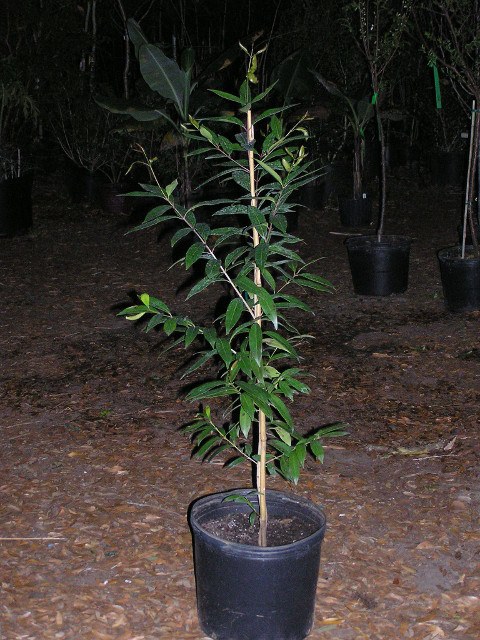
3g Jamun
